|
|
I’ll admit that sometimes it feels like China is a place to be endured, not enjoyed. It takes a strong state of mind
not to be frustrated by the difficulties encountered due to the language barrier, lack of personal space and different
hygiene rules. Within one week of being on mainland China a part of me was longing for the modernity and
convenience of Hong Kong. But China keeps its cards close to its chest, and just when you think it’s down and out
(or you are down and out on China), it pulls through with an ace in the hole. You can go from having a crappy day
to an unforgettably good day in the space of a few hours.
To illustrate this, after Shanghai Jarrod and I traveled to Hangzhou for a few days. For our first full day in the city
we decided to take the bus to the tea museum and then on to Longjing (Dragonwell) tea village to see where the
tea is grown. We asked for directions at our hostel and they seemed straightforward enough. Take the #7 bus to
Hangping Rd. and then transfer to the #27 which would take us to the museum. Our troubles began when we got
on the right bus but traveling in the wrong direction due to the fact that the stops were all written in Mandarin at
the bus stop. When we realized we were going the wrong way we got out off the bus and tried to take a taxi. We
pointed in our guidebook to the Mandarin translation of “Tea Museum” when we approached the taxi. The driver
looked at our book for a moment, and then frowned and grunted and drove off. This happened twice and we were
beginning to think Hangzhou taxi drivers do not like Westerners so much. We later found out that these taxi drivers
were not being rude, they just did not know how to read, and even though we were showing them where we
wanted to go in Mandarin they were unable to understand. So there we were, two hours after departing our
hostel, further away from our destination than when we started. Our only option was to climb back on the #7 bus
in the opposite direction. We still had to figure out where Hangping Rd. was. We pulled out the directions that the
hostel had written for us, and tried to match up their Chinese characters with one of the stops listed on the route
inside the bus. A lady saw us struggling and came over to help. Despite her very limited English, she communicated
where we should get off and even recommended another tea village that she liked. We sat smiling and nodding at
each other for several stops before we arrived at Hangping Rd. We had originally planned to visit the museum and
tea village in the morning and return back to our hostel for lunch around 1pm. By the time we made it to Hangping
Rd. it was already 12:45pm and we still had another bus to navigate before we reached our first destination. So we
ducked into a pastry shop and bought two meat pastries for lunch on the go. We managed to guess the next stop
correctly and climbed off the bus near the museum. It was set in a tranquil garden at the base of steep mountains
covered with tea bushes. Workers in tall straw hats dotted the tea fields, picking the leaves and filling up big bags
with the fresh tea. We made a quick pass through the museum, long enough to learn there are six types of
Chinese tea—green, yellow, white, black, oolong and dark tea. Then we made our way into the village (we found a
taxi driver who could understand our attempt at saying “tea village” in Mandarin). The taxi drove through a long
and winding road lined with bamboo. It emerged far away from the hustle and bustle of central Hangzhou into a
tranquil village nestled in the terraced mountains lined with tea bushes as far as we could see.
|
|
|
|
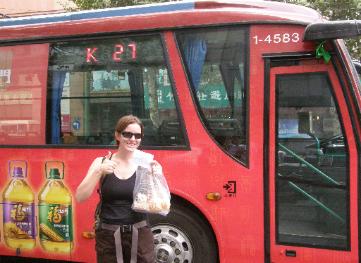 |
|
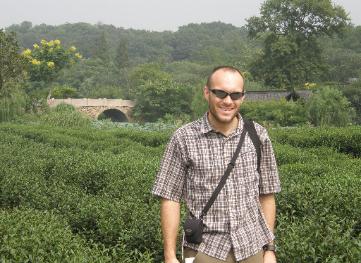 |
|
|
|
Green tea, anyone? Jarrod standing in the middle of a field of
tea bushes in front of the tea museum.
|
|
|
Finally, the #27 bus! Erin celebrates finding the second bus en
route to the tea museum and village.
|
|
|
|
|
|
|
We were immediately approached by a lady offering to take us to her house to “taste tea”. Not sure if this was
a scam or not, we continued on our own through the village. Soon we were approached again by another Chinese
lady who wanted us to come “taste tea” at her house. We tried to say no, but she kept chattering away at us in
Chinese. At first it was funny and she seemed nice enough, but after a few minutes we realized that she wasn’t
going to leave us alone and she also wasn’t going to stop talking to us in Mandarin. It was like she thought if she
talked long enough to us that eventually we would miraculously be able to understand her. Jarrod tried the nice
approach, smiling and saying “no tea” very politely. When that didn’t work, I tried to explain to her very firmly that
we were not going to her house and we did not want her tea. As soon as the worlds were out of my mouth I
realized the ludicrousness of what I was doing—speaking in my own language and hoping she would understand,
just as she had been doing to us for the past thirty minutes. After about a half a mile we passed the turnoff to her
house where she stopped. We waved goodbye and kept walking up the hill. As we looked back she still stood
there staring at us.
|
|
|
|
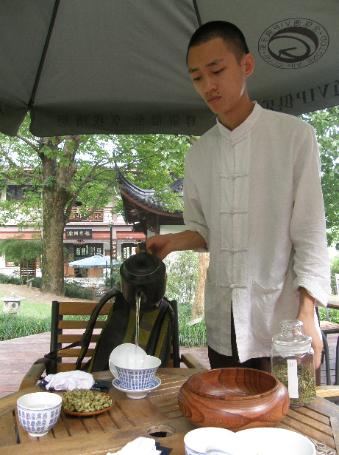 |
|
|
Eventually we stumbled on the neighborhood’s central
attraction which is kind of like a park built into the hills
where tea is grown. There were a bunch of traditional
Chinese style pagodas, small altars, teahouses and paths
wandering up and down the hills. We stopped at one
scenic teahouse and ordered a pot of tea. We had to
have the waiter show us how to drink the tea without
getting a mouthful of tea leaves, as hot water is poured
directly over the loose leaves, which then float about in
your cup. Once we mastered the technique of skimming
the top of the tea with the lid to our cup to push back the
tea leaves, we settled in and drank about 6 cups. It was
nice to have such a calm place to sit and relax after our
harrowing morning of getting to the village.
On our way back to the bus stop we decided to walk
through the village a bit. Most of the women pushing tea
had gone home and we had a peaceful walk among this
unique village. It seemed everyone we saw was in the
tea business. They were either selling it, growing it,
picking it, or packaging it. We decided that we did want to
buy some (but not from the piranha like lady that followed
us). On our way back to the bus stop we passed a
woman sweeping her front porch. When we passed her
she offered us tea as we were hoping. We pulled out our
charades skills and pantomimed that we did not want to
drink tea now, rather we wanted to buy some to take
with us. She seemed to understand and disappeared into
her house for a moment. She returned with a large metal
bin filled with three different bags. She opened each of
|
|
|
|
|
|
|
Tea tasting in Longjing tea village
|
|
|
|
|
|
them and showed us the contents. They were filled with three different qualities of Dragonwell tea. She scooped
some up and had us smell each one. We could only tell that the highest quality tea had a stronger green tea smell.
We decided to buy two cans of the best stuff and we began the negotiation process with her. She wrote her
offering prices on a piece of paper and showed it to us. We then countered with a price 40% lower. She laughed at
our attempt to draw the Chinese dollar sign and then wrote down her counteroffer. This went on until we had
agreed upon a price. After taking some pictures and watching her package up our tea, we left the village.
|
|
|
|
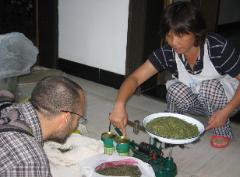 |
|
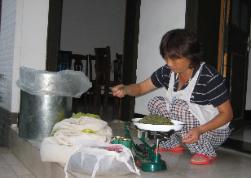 |
|
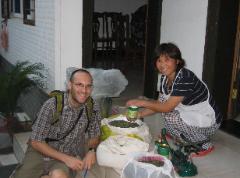 |
|
|
|
|
|
|
Explaining the different tea qualities
|
|
|
Weighing the tea
|
|
Packaging the tea
|
|
|
|
|
|
|
What started out as a frustrating day turned out to be one of our favorite days in China yet. This village was
unlike the China we had seen so far in the cities of Shanghai and Hangzhou, and really felt like an unspoiled pocket
of the country. The comraderie of the village, the dominance of the tea industry and the landscape of tea bushes
clinging to the steep hills provided us with a glimpse of a slower paced China that couldn’t have come at a better
time for us. We look forward to enjoying a cup of Dragonwell green tea when we are back home and remembering
this day.
|
|
|
|
return to china overview next china journal>
|
|
|
|
|
|
|
|

